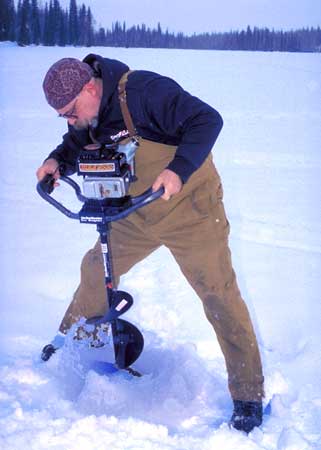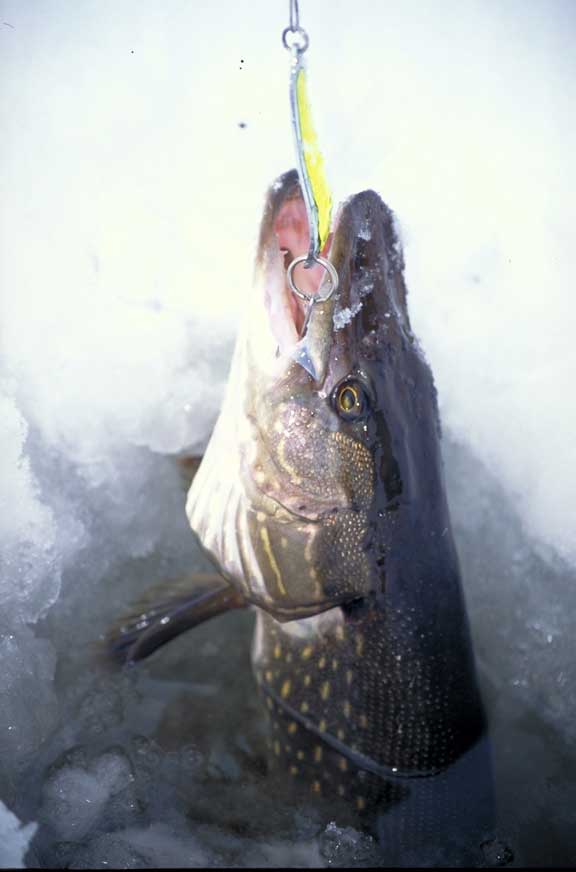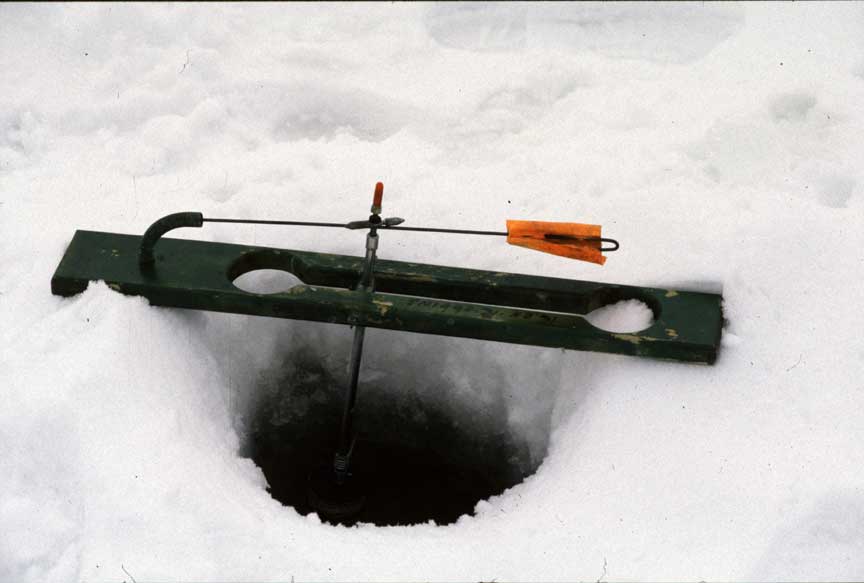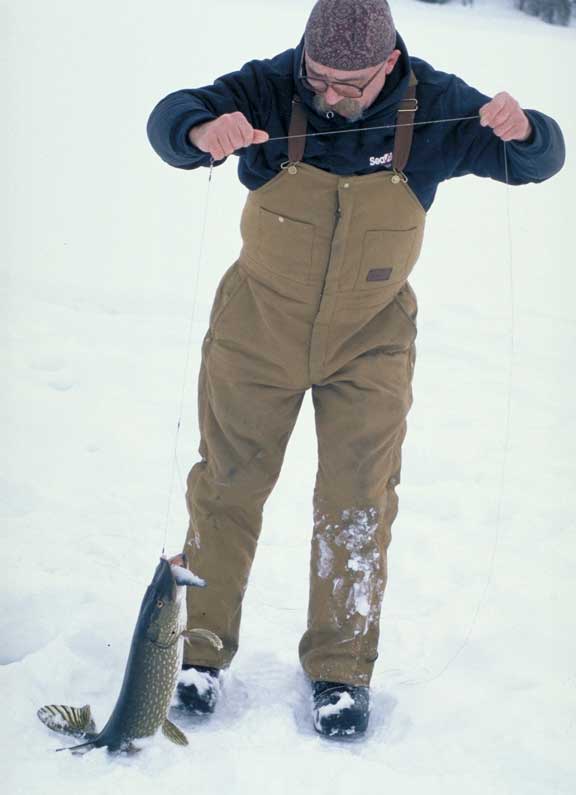Ice Fishing Alaska
by Rene Limeres
The inevitable descent of the snow line and accompanying freezing temps ends our open water season here in Alaska in late fall. This can be a time of great sadness for most anglers, when they put their rods and other gear in the closet and prepare for a long, fishless winter.

But the true diehards, for whom the "tug is the drug", merely view this as a transition to a different form of the sport they love, one that provides unique and exciting diversion all winter long - the world of ice fishing. Now, standing out in the cold and dangling a line through the ice isn't for everyone, but if you haven't yet done so, you need to embrace the season and give Alaska's abundant winter angling a shot, if only to say you've tried it. Who knows, you might even like it and join the frostbitten ranks who don't mind their fishing served cold and with ice. Other than the initiative and a little specialized gear, it doesn't take much. Read on for the basics of how to ice fish in Alaska.
Comfort & Safety
The greatest challenge to winter fishing in Alaska is, of course,
maintaining a reasonable measure of comfort and safety. Setting out across
ice-covered bodies of water is risky business anywhere, but especially so
here, where conditions can vary so quickly and help can be far off or
non-existent. Likewise to staying warm outdoors in
the depths of winter;
Alaska's cold demands your utmost respect and preparation.
You should not plan on doing any ice fishing along the southern mainland
of Alaska until early December in most years, when a 4-6 inch layer of
clear hard ice
uniformly covers most of the bodies of freshwater. (Any
prolonged spells of unusual weather during late fall-early winter may
affect the formation of this safe ice layer- unseasonably warm
temperatures, early heavy snowfall, etc., so keep track of the conditions
as the season develops.) Larger lakes such as Skilak, Louise, Summit,
etc.,  take longer to develop uniformly safe ice than the numerous smaller
lakes scattered across the Matanuska and Tanana valleys and northern Kenai
Peninsula. Lakes along the coast, particularly those in Southeast, may not
freeze adequately until much later in winter, or in some years, not at
all. Be wary of overflow conditions that can flood the surface of lakes
with a layer of water. Early heavy snows can likewise create extremely
hazardous conditions as they insulate lake surfaces from the cold. Always
check with local sources on current conditions before venturing onto any
frozen lake.
When planning your trip, remember that going off alone on any remote
Alaska wilderness foray is never a good idea, especially in winter, so
you'll want to include a buddy or a small group of friends for anything
beyond an outing to local urban waters. Warm clothing, some kind of
shelter and personal survival gear are essential. Here's a list of the
bare minimum of personal gear I would bring:
take longer to develop uniformly safe ice than the numerous smaller
lakes scattered across the Matanuska and Tanana valleys and northern Kenai
Peninsula. Lakes along the coast, particularly those in Southeast, may not
freeze adequately until much later in winter, or in some years, not at
all. Be wary of overflow conditions that can flood the surface of lakes
with a layer of water. Early heavy snows can likewise create extremely
hazardous conditions as they insulate lake surfaces from the cold. Always
check with local sources on current conditions before venturing onto any
frozen lake.
When planning your trip, remember that going off alone on any remote
Alaska wilderness foray is never a good idea, especially in winter, so
you'll want to include a buddy or a small group of friends for anything
beyond an outing to local urban waters. Warm clothing, some kind of
shelter and personal survival gear are essential. Here's a list of the
bare minimum of personal gear I would bring:
- Layered wool, silk or polypro undergarments
- Warm socks & hat
- Insulated coveralls or snowmachine suit
- Hooded, Arctic weight, insulated parka
- Rubber coated insulated footwear (bunny boots)
- Arctic weight mittens with wool or polypro glove liners
- Long insulated rubber gloves
- Personal light source- flashlight or lantern
- Large Thermos with coffee/tea
- Water/Snacks/Food
- Handwarmers
- Winter weight sleeping bag or down comforter
- Matches/Lighter
- Cell phone
Access
Many of the state's less remote but productive bodies of water for ice fishing can be accessed from the road system or by short trail. (Check with the Alaska DOT and land managers for winter road and trail conditions.) For the harder-to-get-to places, Alaska ice anglers use skis and snowmachines pulling sleds to transport themselves and their gear. Small planes equipped with skis are another option to open up endless possibilities off the road system.
Ice Fishing Gear
For the gear you'll need for most Alaska ice fishing forays, you can keep it quite simple: some basic tools for cutting and clearing holes, a shelter of some kind, a fire or heat making device, and your rigs and paraphernalia for fishing.
For early season fishing, an "ice spud" bar will work fine to chip through
the thin layer of ice covering the surface of most lakes, but as winter
progresses, ice augers become the tool of choice for lessening the chore
of boring through thick ice. (The ice spud remains an essential tool
throughout the season for enlarging and chipping  away ice from the hole.)
If you plan on only fishing urban ponds and some of the more popular lakes
along the road system, you can get by with an ice spud or hand auger
throughout the season, to open up and enlarge holes that have been kept in
use by locals. But if you plan on fishing remote sites, especially larger
lakes, where numerous test holes may be required, you should get a power
auger, to save time and energy punching through thick ice (which can reach
several feet by late winter in Alaska). Whether you use hand or power
augers, make sure your blades are sharp before leaving home, and take care
in the field not to dull them.
away ice from the hole.)
If you plan on only fishing urban ponds and some of the more popular lakes
along the road system, you can get by with an ice spud or hand auger
throughout the season, to open up and enlarge holes that have been kept in
use by locals. But if you plan on fishing remote sites, especially larger
lakes, where numerous test holes may be required, you should get a power
auger, to save time and energy punching through thick ice (which can reach
several feet by late winter in Alaska). Whether you use hand or power
augers, make sure your blades are sharp before leaving home, and take care
in the field not to dull them.
Sitting on the ice out in the open, where you are totally exposed to Alaska's winter chill, you'll have a difficult time staying warm, no matter how well you are dressed, unless you bring some kind of wind break. This can be something as simple as a tarp or an old dome tent (with a hole cut in the floor) or more elaborate, like the trick, portable ice shelters sold nowadays, that fold down into sleds, or more permanent, plywood ice houses like those used in the upper Midwest and Canada, that are hauled to site by trailer. Anchoring tarps and tents down so they don't blow away is simplified by freezing stakes, guy lines and frames into the ice. (You can use the ice spud or small hatchet for chopping.) A wood fire is essential for warmth if you're fishing out in the open, but if you have some kind of enclosed shelter, a space heater (propane or kerosene) will do the job. (Don't forget sawing/chopping tools and wood if you plan on building a fire; fuel if you going to use a space heater.)
For ice fishing rigs, you can go simple or elaborate. There are specially designed, short ice fishing rods and rod-reel combos sold through the catalogs (and stores) that work great for fishing through ice holes, but you can do just as well for most situations using the bottom half of an ultralight spinning rig (filled with 6-10 lb. line for rainbow trout and landlocked salmon; heavier for pike, lake trout, burbot and charr) or light fly rod (spooled with floating or sinking line & 6-10 lb. mono leader for trout & salmon; heavier for pike, lake trout, burbot and charr). For fishing bait unattended, the classic "tip-up", a rig with expandable cross members to hold it above the hole and triggered flag to signal a bite, works great. (Remember that in most Alaska waters, you are limited to fishing only two baited lines.) For hand jigging, you might forego the rod altogether and opt for simple, trouble-free, coiled hand-line jigging rigs. Bright metal lures adorned with some kind of bait or scented oil are the standard enticements used to rouse sluggish fish this time of year. For rainbow trout and the various landlocked salmon species stocked by ADF&G, small (less than an ounce) attractor-colored jigs and jigging spoons fished with cured salmon eggs or shrimp are most popular and effective, as are small spinners (1/2 ounce or less). Bait can be fished alone, with lead shot and usually a bobber. For lake trout, arctic charr and northern pike, large, bright spoons, 3-5 inches, featuring a splash of attractor color (red, orange, chartreuse) are the ticket, especially when fished with a strip of bait such as herring, whitefish, smelt or sucker. (Remember it is illegal to fish live bait in Alaska.)
Techniques for Alaska Ice Fishing
Planning a fishing strategy for these ice-bound waters can be as simple as
looking for well-used holes in the most popular lake locations, and
lowering baits or lures down into them. But if you're the kind (like me)
that seeks more remote and isolated waters, you'll have to work at finding
fish in a much different environment than you deal with during the open
water season.
Winter fish are not necessarily going to be found in the same locations
and depths
 that they are in summer, as the reduced temperatures, light and
water inflows/outflows of winter greatly affect the movements and feeding
habits of the resident fish.
Knowing the overall morphology of the lake you are going to fish will be
extremely helpful. ADF&G has numerous lake charts available (as hard copy
in field offices and on-line) that show depth and bottom contours of many
popular ice fishing destinations, as well as quite a few of the more
remote and obscure sites. If you can get one of these lake maps, look for
dropoffs, shoals, bars, stream mouths, weed beds, outlets, points, and any
other structures that might attract fish. If you can't get any lake maps,
talk to locals or other fishermen who might have knowledge of the waters
you are interested in and can direct you to the most productive fishing
areas. Otherwise, you'll have to rely on guesswork and trial and error to
locate the best spots.
Standard procedure for fishing remote and untried waters is to punch a
series of well-spaced holes following the bottom contour along the most
likely stretch of shoreline or other structure and try fishing them until
you find some action. Work the holes for at least an hour before moving on
to a new location. It's always a good idea, if you have enough bait with
you, to chum the holes with some finely chopped bait. Don't overdo it; the
idea is to create a scent trail to entice fish in, not to feed them. (If
you have some kind of shelter erected over the hole, it will cut down on
the ambient light so you can peer down into the waters and watch for any
action after you drop the bait down.)
You should work your lures/bait vigorously up and down at various depths
on your attended lines, and check all your rigs frequently to make sure
your baits are intact and fresh. Deeper areas don't necessarily hold fish
like they might during open water season, as they become anoxic (devoid of
oxygen) as winter wears on and fish seek the warmer and more oxygen-rich
shallows. So typically you might hook up well above bottom when fishing
trout, landlocked salmon and northern pike, especially later in the
season.
that they are in summer, as the reduced temperatures, light and
water inflows/outflows of winter greatly affect the movements and feeding
habits of the resident fish.
Knowing the overall morphology of the lake you are going to fish will be
extremely helpful. ADF&G has numerous lake charts available (as hard copy
in field offices and on-line) that show depth and bottom contours of many
popular ice fishing destinations, as well as quite a few of the more
remote and obscure sites. If you can get one of these lake maps, look for
dropoffs, shoals, bars, stream mouths, weed beds, outlets, points, and any
other structures that might attract fish. If you can't get any lake maps,
talk to locals or other fishermen who might have knowledge of the waters
you are interested in and can direct you to the most productive fishing
areas. Otherwise, you'll have to rely on guesswork and trial and error to
locate the best spots.
Standard procedure for fishing remote and untried waters is to punch a
series of well-spaced holes following the bottom contour along the most
likely stretch of shoreline or other structure and try fishing them until
you find some action. Work the holes for at least an hour before moving on
to a new location. It's always a good idea, if you have enough bait with
you, to chum the holes with some finely chopped bait. Don't overdo it; the
idea is to create a scent trail to entice fish in, not to feed them. (If
you have some kind of shelter erected over the hole, it will cut down on
the ambient light so you can peer down into the waters and watch for any
action after you drop the bait down.)
You should work your lures/bait vigorously up and down at various depths
on your attended lines, and check all your rigs frequently to make sure
your baits are intact and fresh. Deeper areas don't necessarily hold fish
like they might during open water season, as they become anoxic (devoid of
oxygen) as winter wears on and fish seek the warmer and more oxygen-rich
shallows. So typically you might hook up well above bottom when fishing
trout, landlocked salmon and northern pike, especially later in the
season.
|
|
|
|
|
|
|
|
|
|
|
|
|
|
|
|
Arctic charr, lake trout and burbot are generally taken deeper than other species. If you're one who uses electronic fishing aids to enhance productivity on wide open marine and lake environments, you might want to consider using a fish finder for your ice fishing forays. There are reasonably priced, portable, cold weather-resistant units available now that can save a lot of time on unfamiliar waters, particularly on the larger lakes. Once you do locate fish, the fun begins. They tend to school up this time of year, so you can generally expect some fast and sustained action once the bite begins, particularly with trout and landlocked salmon. A hole in the ice that lets light and food in, not to mention the added stimulus of a bright lure and frenetic movement (and noise) of a hooked fish, creates a powerful draw for fish near and afar. And on many occasions, I have had bigger fish drawn in the longer I continued fishing through a particular hole. Much has been said about the best time of day for the bite when ice fishing, but I have had good action fishing just about every hour of the day, including the dead of night, so I think it isn't as much a factor as it is during open water season, though I know many experienced ice anglers reading this may disagree. Early morning and late afternoon are said by many to be the most productive times for ice fishing. If you want to keep a good hole open for later, like if you plan on coming back the next day, best thing to do is cover it with something like a piece of wood or cardboard, or even some spruce boughs, then shovel a pile of snow over it. That will insulate it and at least keep the ice formation to a minimum for a day or two. Any fish you want to keep should be cleaned (use the offal for chum) and put on ice (easy to do this time of year). Fish to be released should not be taken out of the hole, but freed using a pair of pliers to grip the hooks and twist them out.
Where to Go
There is a super abundance of easily accessed and productive ice fishing
in Alaska. The Alaska Department of Fish and Game has a stocking program
for hundreds of lakes (consult their website or visit one of their offices
for current listings of local stocked lakes, with additional info like
access, stocking history, contour maps, etc.), many  of which receive
regular fish plants right before freeze up, to benefit ice anglers. The
majority of these waters are within easy reach of the state's major urban
areas- around Anchorage, Fairbanks and the Kenai Peninsula.
If you don't care to fish for stocked trout and landlocked salmon, there
are nearly limitless possibilities for fishing wild rainbows, pike,
burbot, charr (arctic, Dolly Varden and lake trout), grayling and even
sheefish across the state's trackless interior, western and far north
regions. (ADF&G is also a great resource for information on remote,
unstocked lakes.)
Traditionally, the best times for ice fishing are early and late in the
season. Late winter (March into early April) is a favorite time for many
ice anglers as the longer, brighter days and warmer temps have a
stimulating effect on anglers and fish alike. Fishing as soon as the lakes
develop a safe ice layer is also very productive and easiest, with the
least amount of hole drilling.
If you do some local day trips, take some kids along with you. Their
enthusiasm and appreciation for even meager fare like put-and-take
rainbows is contagious and will warm your heart (if not your feet and
hands), plus it's good to get them outside and show them there's more to
do in winter in Alaska than be couch potatoes.
Here's a small list of some of the more popular lakes to try:
of which receive
regular fish plants right before freeze up, to benefit ice anglers. The
majority of these waters are within easy reach of the state's major urban
areas- around Anchorage, Fairbanks and the Kenai Peninsula.
If you don't care to fish for stocked trout and landlocked salmon, there
are nearly limitless possibilities for fishing wild rainbows, pike,
burbot, charr (arctic, Dolly Varden and lake trout), grayling and even
sheefish across the state's trackless interior, western and far north
regions. (ADF&G is also a great resource for information on remote,
unstocked lakes.)
Traditionally, the best times for ice fishing are early and late in the
season. Late winter (March into early April) is a favorite time for many
ice anglers as the longer, brighter days and warmer temps have a
stimulating effect on anglers and fish alike. Fishing as soon as the lakes
develop a safe ice layer is also very productive and easiest, with the
least amount of hole drilling.
If you do some local day trips, take some kids along with you. Their
enthusiasm and appreciation for even meager fare like put-and-take
rainbows is contagious and will warm your heart (if not your feet and
hands), plus it's good to get them outside and show them there's more to
do in winter in Alaska than be couch potatoes.
Here's a small list of some of the more popular lakes to try:
Anchorage Area: Jewel, Mirror, Beach, Clunie, Otter, DeLong, Sand, Green
Fairbanks Area: Chena, Polaris, Ballaine, Moose and Grayling lakes; 28 Mile Pond
Tanana Valley: Tangle, Minto and Tetlin lakes systems; Harding, Birch, Quartz, Geskakmina, Dune, Otto, Rainbow, Craig, Koole and Bolio lakes
Kenai Peninsula: Summit, Trail, Kenai, Hidden and Skilak lakes; Swanson River Road lakes, Swan Lake Road & Canoe System lakes
Matanuska & Upper Susitna Valley: Big Lake system; Nancy Lake System, Kepler-Bradley lakes, Petersville Road lakes, Wasilla, Red Shirt, Long, Seventeen Mile,Benka, Christiansen, Carpenter, Memory, Diamond, Chelatna, Clarence and Stephan lakes
Glennallen & Copper Valley: Louise/Susitna, Crosswind, Deep, Fish, Tolsona, Paxton, Summit, Tonsina, Strelna, Silver, Van, Copper-Tanada and Long lakes
Bristol Bay: Wood-Tikchik Lakes, Lake Clark; headwater lakes, Togiak and Kanektok rivers, Katmai lakes
Northwest: Walker, Feniak, Wild and Selawik lakes; Hotham Inlet (spring sheefish)
Arctic: Teshekpuk, Elusive, Galbraith, Chandler, Old John, Chandalar, and Bob Johnson lakes
Editor's Note: Many other lakes suitable for ice fishing can be found at the ADF&G Lake Fishing Information pages, which include access information, bathymetric maps, and other items of interest to fishermen.
Rene Limeres is a long-time Alaska wilderness fishing guide and writer/publisher who lives north of Anchorage. Check out his publications and fishing program atwww.ultimaterivers.com
